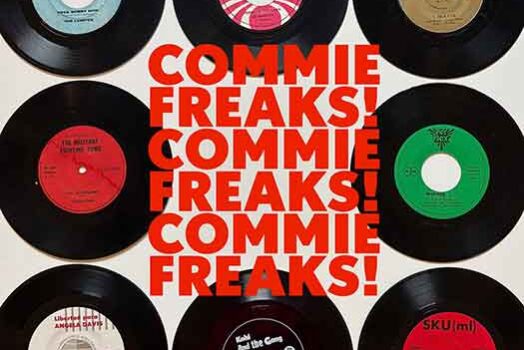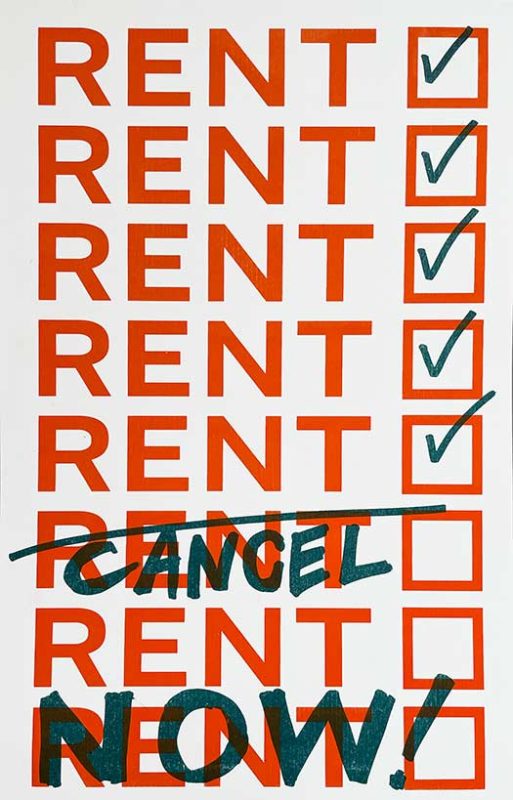Daniel Tucker has written a nice piece about Justseeds that is going to be published in the upcoming issue of Alarm Magazine. It is also on their website here. And for those who don’t want to click away from us, here it is:
Justseeds: Reminders of Emancipation and Justice
by Daniel Tucker
If in the last ten years you’ve traveled under the auspices of attending a lefty rally, protest, or conference, or you’ve spent time in a community center, a crusty punk group house, a union hall or a progressive bookstore, then you’ve probably seen some of the graphic arts distributed by justseeds.org. One particularly popular set of posters is the Celebrate People’s History series, organized by Justseeds founder Josh MacPhee. These posters, highlighting hidden and obscured histories of social movements, from the abolition of slavery to ACT-UP, show up in the most surprising and diverse contexts. In public school classrooms, they serve as the graphic curriculum equivalent to Howard Zinn’s People’s History of the United States, whereas in the social centers and bookstores of today’s leftist and sub-cultural movements, they serve as a constant reminder of the roots of struggle and of significant battles for emancipation and justice.
Justseeds was started in Chicago in 1997 and was initially conceived as a distribution platform for MacPhee’s artwork (which included an assortment of stenciled and block prints, zines, and the people’s history posters).
Carlos Fernandez of Chicago Jobs with Justice was one of many activists that encountered this work in the streets, on tables at political conferences, and on the walls of social-movement centers. He reflected, “In my encounters with the work spread by Justseeds, I realized that art’s role in political struggle could be bigger. It has offered valuable commentary, but by politicizing its production—the costs, the collaboration—it could also show how to put the ideals we voice into creative practice. I saw this in lots of small but important ways: how it was made, where it appeared, how it got into people’s hands.”
Over the years, Justseeds gained street cred and notoriety amongst a diverse set of young teachers, community organizers, contemporary artists, and graffiti writers. As this happened, MacPhee took steps to build stronger networks in his new milieu of left-leaning artists (specifically the low-budget producers like print makers and graffi ti writers). His organizational aspirations found inspiration in the late ’80s Boston-area punk scene and various anarchist, prison solidarity, and anti-racist networks in the ’90s.
According to MacPhee, “Networks and organization are not simply tools to be more effi cient or successful, but the building blocks of creating a new world. Our current society is structured to make us feel like atomized individuals, alienated from others and ourselves. This makes us more vulnerable to the massive amount of corporate and state propaganda we are bombarded with daily. By building organizations and communities where we try to really connect, understand, and support each other, we can build the collective tools necessary to both live our lives for personal self-fulfillment as well as change the larger society so that all will be free to do the same.”
MacPhee was doing the legwork to cultivate a new community through the facilitation of such ambitious projects as the Celebrate People’s History poster series (which now has posters made by over forty artists from across the globe and can be subscribed to like a magazine), the Stencil Pirates book (in its fifth edition from Soft Skull Press), the Street Art Workers (SAW) network of printmakers who produce coordinated campaigns, and several incarnations of the Paper Politics exhibit with over 200 printmakers.
Simultaneously, there were other movements and organizations that were emerging and changing the state of independent culture and politicizing young people. This time period saw a proliferation of art collectives from the Critical Art Ensemble and Yes Men to the Beehive Design Collective and the No RNC poster project. Diverse communities of cultural producers and political organizers came together with events such as the Drawing Resistance traveling exhibition (organized by Sue Simensky Bietila and Nicolas Lampert, now a member of Justseeds), the Department of Space and Land Reclamation convergences, and a wide range of locally oriented and anti-war exhibitions.
One of those projects was the No RNC Poster Collective, which developed around a protest against the Republican National Convention (RNC) meetings in 2004 in New York City and eventually morphed into a regular and consistent group called Visual Resistance (VR). For several years, VR was responsible for networking and documenting street artists and activists throughout the city and developed such ambitious projects as the Ghost Bike memorials to bikers killed by cars. The group’s blog was the critical counterpart to a growing industry of slick graffiti websites and coffee table books—they offered a space for people concerned with content and ideas in addition to having a general interest in public space and unsolicited public art. It was graffiti with a message. Several members of VR met MacPhee as he started to gain more attention on a national scale and through the networking and exhibition projects he was initiating.
It’s been amazing to have so many people offer help, and enlightening to realize how few places there are to get interesting, intelligent, and political art.
As Justseeds continued to expand, it outgrew MacPhee’s home office in Chicago. In 2004, he connected with the folks at the then-thriving and now-deceased magazine Clamor, for whom he had previously produced graphics, and they took over his inventory and mailorder. This arrangement only lasted two years before Clamor had financial problems that forced it to stop production. The bank foreclosed Clamor’s online store, which was the “backend” of several small businesses (one of the largest being Justseeds) that went down with it.
After slaving away unpaid to distribute ideas and organize artists, now was the test to see who was listening. Following a plea to his list of e-mail subscribers, MacPhee received over 80% of the funds needed to stay afl oat in just three weeks. In his next e-mail, MacPhee offered thanks to the donors, writing, “It’s been amazing to have so many people offer help, and enlightening to realize how few places there are to get interesting, intelligent, and political art.” He also used this occasion to warn fans of Justseeds that there were changes in the future—changes for the better—and to not forget the project while it went into a hiatus for several months to reorganize. Unbeknownst to fans and supporters, MacPhee was in talks to combine Justseeds with a network of individual artists (mostly printmakers and graffiti artists) and the Visual Resistance group. In the fall of 2007, the “Justseeds/Visual Resistance Artists’ Cooperative” was formed. The collective’s initial e-mail newsletter read: “Justseeds/Visual Resistance Artists’ Cooperative is a community of artists who have banded together to collaborate and sell their work. Our website is not just a place to shop, but also a destination to find out about current events in radical art and culture. Our blog covers political printmaking, socially engaged street art, and culture related to social movements.”
Composed of over a dozen artists living in five states, JS/VR Artists’ Cooperative is a diverse bunch capable of doing more work in more places that MacPhee ever could have accomplished on his own. The aesthetics of JS/VR reference the baby-boomer era as well as the 1930s, but the group’s varied composition results in a much more diverse aesthetic than the left has seen in one place in recent memory. The influences come from historical social movements as much as from youth cultures like punk and hip hop.
Speaking about the networking potential of working in a group, JS/VR member Nicolas Lampert explained, “All these contacts expand the reach of Justseeds. Of course, being a decentralized co-op also allows each artist to focus more on the city/region that they operate out of, which has been great for developing new projects and for tabling local events. We have also divided the tasks of running the co-op, so that the workload is shared.”
Though some of the members are self-taught, others went to art school to be trained and have had recognition in the commercial art market. Still, what primarily ties these artists together is their commitment to engage audiences through distribution and dissemination. Some may use street posts and walls, whereas others distribute via snail mail, zines, and T-shirts. They see a direct relationship between audience and distribution, which is the result of spending years participating in sub-cultures that are invested in their own networks and audiences.
The cooperative’s Web store only carries the creations of members that work to keep it afloat—thus making it a worker-run company. Every month there are new posters and graphic projects being added to the store. The blog is increasingly becoming an online hub for anyone interested in the intersection of art and politics, and it places a particular emphasis on street art, graphics, posters, and collectives. One can also find reports of the members’ travels, as well as tons of calls for participation in art shows, publications, and campaigns. The calls to action are a characteristic that is especially important to this crew, because it wants to build stronger and more functional networks of socially engaged artists. The site creates an entry point into a world that is gaining prominence and promise—a world where art makers are talking, collaborating, merging, and working. The story of Justseeds from old to new is inspiring for those of us that believe in cooperation—and in the role that cultural production plays in envisioning the world more like we want it to be.
For more information:
www.justseeds.org or www.myspace.com/justseedscooperative. Daniel Tucker works as an organizer in Chicago, focused primarily on public space, social movement history, and geography. He is currently the editor of the biannual journal and public program series AREA Chicago (art/research/education/activism— areachicago.org). For more information, see miscprojects.com.







